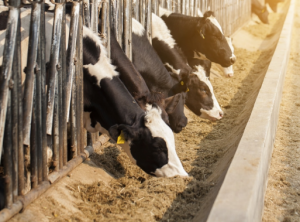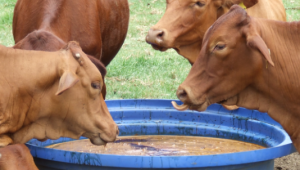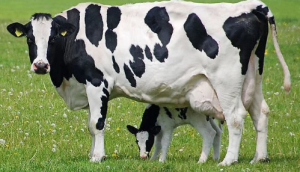 Dairy farming will never be profitable if you are not producing enough milk. On average, a dairy cow produces 6-7 gallons of milk in a day. Certain breeds produce between 6,800kg and 17000kg per year. The udder milk produced will vary from one breed to another and other factors may also come to play.
Dairy farming will never be profitable if you are not producing enough milk. On average, a dairy cow produces 6-7 gallons of milk in a day. Certain breeds produce between 6,800kg and 17000kg per year. The udder milk produced will vary from one breed to another and other factors may also come to play.
Normally, the milk levels will peak around 40-60 days after calving. It then declines steadily until when milking stops after 10 months. The dairy cow is then dried off sixty days to the expected calving date. This gives the farmer a 12-14 months productive inter calving cycle of which 10 are milking months.
What Variables Determine Dairy Farming Profitability?
Milk Production
The volume of milk sold is quite vital in determining whether you are making a profit or loss. It is the volume that will determine whether you can maximize your revenues. An increase in production goes a long way in diluting the burden of fixed costs. It makes the farming self reliant and the farmer enjoys a profit.
Diet Optimization
 The amount of milk produced per kilo of dry matter intake gives a reflection of a cow’s profitability. Feeds are quite costly and the dairy cow needs to produce milk proportional to feeds intake. A farmer pegs their expectation on milk production and will only be motivated to improve the diet proportions if the milk produced meets requirements.
The amount of milk produced per kilo of dry matter intake gives a reflection of a cow’s profitability. Feeds are quite costly and the dairy cow needs to produce milk proportional to feeds intake. A farmer pegs their expectation on milk production and will only be motivated to improve the diet proportions if the milk produced meets requirements.
Milk Prices
Much as the cow may produce huge volumes, if the market is not favorable one may end up making losses. Milk prices are determined by many factors in the market and may shift over time. The quality of milk will also determine the sale price. The command of milk composition (fats and proteins) as well as milk quality (somatic cells count and germs) will definitely affect the sale price.
Milk Preservation And Value Addition
 Dairy products are quite perishable. A lot of milk goes to waste. This results in huge losses to the farmer. For the dairy farm to be profitable, you need to learn how to preserve your milk.
Dairy products are quite perishable. A lot of milk goes to waste. This results in huge losses to the farmer. For the dairy farm to be profitable, you need to learn how to preserve your milk.
Most of the milk preservation techniques double as value addition techniques. Your milk will fetch higher prices when converted into competitive products. We have gone an extra mile to research on the best milk preservation and value addition techniques. These should boost your margins.
Control And Maintenance
Just like in other businesses, there is safety in numbers. Though the maintenance costs will be proportional to the number of animals kept, it is more profitable keeping a huge number of animals.
Control and maintenance costs such as manure control, animal housing, employee costs and milking equipment will be easier to manage with a huge number of cows.
How Do You Increase Milk Production In Dairy Cows?
This is a common question across the globe. A dairy cows’ profitability is directly related to its milk production and every farmer wants to improve the cows’ production. Many farmers assume that increasing production has everything to do with increasing feeds and improving the concentrate ratios. While this may see you increase your production it may not be the ultimate solution.
10 Tips To Increase Your Udder Milk Production
Dry Cow Preparations
 Prepare your cow while it’s still in the dry stage. Dry period management and nutrition affects dairy cows’ health and performance. At this stage, ensure that you are;
Prepare your cow while it’s still in the dry stage. Dry period management and nutrition affects dairy cows’ health and performance. At this stage, ensure that you are;
- Avoiding overfeeding of the cows
- Optimizing cow comfort
- Maintaining dry food/matter intake at 28 to 32 pounds a day
- Observing hoof health
- Preventing gain of BSC (body condition score)
Reduce Risk Of Sub-Clinical Milk Fever
Prevent the risk of sub-clinical milk fever, also known as low blood calcium) during the first weeks of lactation. Low blood calcium (8.0 milligrams deciliter and below) correlates to;
- High somatic cell count
- Low milk production
- Metritis
- Ketosis
- Low feed intake
- Problematic uterine involution
Optimal Feeding After Calving
- Ensure provision of 10-15 gallons of warm water. Preferably with drinkable drench
- Provide 5-10 pounds of grass/alfalfa hay
- Ensure feed bunks are clean and fresh
- Provide fresh and properly mixed rations
Optimize Overall Cow Comfort
 One of the major bottlenecks dairy farmers have to deal with is cow comfort. Poor cow comfort has numerous repercussions. It can result in poor production and reproduction, infections, culling, lameness and even death. So, what does cow comfort entail?
One of the major bottlenecks dairy farmers have to deal with is cow comfort. Poor cow comfort has numerous repercussions. It can result in poor production and reproduction, infections, culling, lameness and even death. So, what does cow comfort entail?
It can be a little difficult putting a dollar figure on dairy cow comfort. This is because their production and profitability are affected by so many factors. However, it is important to note that cow comfort has a direct impact on production and the overall health of the animal.
Cow comfort needs to be addressed right from the barn, flooring, stalls, sleeping pads, footing, feeding, holding, footing and even treatment sections. There’s just so much to look into when it comes to cow comfort.
Here are some of the key points you need to pay attention to;
- Do not overstock. Only have 80-85 percent of your capacity
- Keep dairy cows in fresh cow groups for 14-21 days
- Minimize social stress more so for first calf heifers
- Provide ample bunk space (30-36 inches per cow)
- Provide cow cooling systems
- Keep cows in the normal herd mates
Prevent Ruminal Acidosis And Maintain Rumen Health
- Ensure that the feeds have lots of digestible fiber. Provide the cow with grass/alfalfa hay after calving
- Monitor buffer intake and provide free choice buffer
- Maintain consistent feeding with no empty bunks
- Avoid diet sorting or slug feeding. This may result in rumen acidosis
Identify Cows With Historic Health Or Metabolic Problems
Cows with a history of ketosis, milk fever and mastitis tend to develop these problems again. Having a keen eye on such cows helps you control health issues in the herd.
Cows carrying twins should be separated from the herd early and placed in the dry group.
Evaluate BCS
Have a good understanding of the BCS. At calving, the target is 3.0 to 3.25. Ensure that cows aren’t going beyond 4.0. Low BCS at calving allow for 0.5-1.0 units within herd variation. This goes a long way in avoiding having overweight in cows.
Overweight cows have a higher risk of ketosis and fatty liver and will have difficulties breeding back.
Provide Feed Additives
 Feed additives go a long way in improving milk production. Studies show that additives;
Feed additives go a long way in improving milk production. Studies show that additives;
- Rumen-protected chlorine – improves liver function and health
- Ionosphere – increase glucose availability
- Supplemental-protected fat -boost energy intake
- Yeast culture – stabilize rumen fermentation
- Protected amino acids – stabilize fermentation in the rumen
Avoid anti nutrition factors
These are factors that will prevent the cows form eating the feeds provided. They include presence of molds in feeds and concentrate, poorly fermented feeds and presence of wild yeast. Feeds containing over 100,000 colonies of molds per gram will be rejected by cows and may result in digestion complications.
Provide Appropriate Amounts Of Antioxidants
Antioxidants such as Vitamin E and Selenium reduce oxidative stress in dairy cows. Oxidative stress may result from injuries, poor air quality or excessive fat mobilization. Such stress can have a huge impact on a cow’s immune system.
Factors That Can Render A Dairy Cow Unprofitable
Infertility
 Infertility is the failure to conceive. This may happen when the heifer is approaching maturity or even after it has calved once or twice. When a cow fails to conceive, it remains open and the milk production dwindles. In heifers that are yet to calf, the farmer is only left counting losses. A cow is at its fertility peak between 60-80 days after calving.
Infertility is the failure to conceive. This may happen when the heifer is approaching maturity or even after it has calved once or twice. When a cow fails to conceive, it remains open and the milk production dwindles. In heifers that are yet to calf, the farmer is only left counting losses. A cow is at its fertility peak between 60-80 days after calving.
Once the cow has shown signs of infertility you ought to investigate the cause. In most cases, infertility will result from poor health, remains of afterbirth from the previous pregnancy, metritis, cysts or uterus infection.
Lameness
Lameness is associated with leg problems or persistent infections. Poor feeding management systems contribute to this problem. If dairy cows are fed on diets that primarily contain highly digestible carbohydrates, they tend to suffer high acidic conditions in the rumen. This results in laminitis that leads to lameness. Such a cow is vulnerable to numerous foot infections and will not be an efficient producer.
Mastitis
Mastitis is one of the major problems that have seen dairy farmers make losses or lose their cattle. This is because it results in persistent fatal udder and mammary gland infections. The infections lead to high somatic cell counts and low milk production.
Mastitis may come in many forms and will be detected by swelling and reddening of infected udder quarters. The milk may also show signs of pus or clots. This is an issue that we have addressed in our post on dairy cows mastitis and can be treated with antibiotics and proper hygiene.
Conclusion
 Milk production determines how profitable your herd will be. It’s thus important that you understand what hinders production and have a few tips to help you improve your production. The tips provided here will set the guideline on how to improve udder milk production and general herd health.
Milk production determines how profitable your herd will be. It’s thus important that you understand what hinders production and have a few tips to help you improve your production. The tips provided here will set the guideline on how to improve udder milk production and general herd health.
The cows may not double their production immediately but you will definitely see some changes over time. Be consistent in your strategies and things will definitely look up.